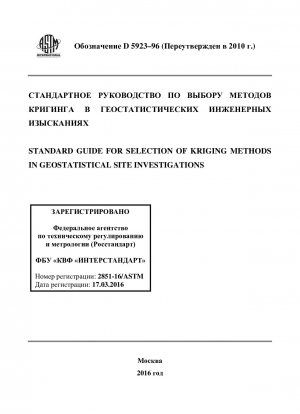ASTM D5923-96(2010)
Standard Guide for Selection of Kriging Methods in Geostatistical Site Investigations
- Standard No.
- ASTM D5923-96(2010)
- Release Date
- 1996
- Published By
- American Society for Testing and Materials (ASTM)
- Status
- Replace By
- ASTM D5923-18
- Latest
- ASTM D5923-18
- Scope
This guide is intended to encourage consistency and thoroughness in the application of kriging methods to environmental, geotechnical, and hydrogeological site investigations.
This guide may be used to assist those performing a kriging study or as an explanation of procedures for qualified nonparticipants that may be reviewing or auditing the study.
This guide encourages the use of site-specific information for the selection of an appropriate kriging method; however, the quality of data, the sampling density, and site coverage cannot be improved or compensated by any choice of kriging method.
This guide describes conditions for which kriging or particular kriging methods are recommended. However, these methods are not necessarily inappropriate if the stated conditions are not encountered.
This guide should be used in conjunction with Guides D5549, D5922, and D5924.
1.1 This guide covers recommendations for selecting appropriate kriging methods based on study objectives, exploratory data analysis, and analysis of spatial variation.
1.2 This guide considers commonly used forms of kriging, including ordinary kriging, simple kriging, lognormal kriging, universal kriging, and indicator kriging. Multivariate, space-time, and other less-frequently used kriging methods are not discussed; however, this is not intended to reflect any judgement as to the validity of these methods.
1.3 This guide describes conditions for which kriging methods are not appropriate and for which geostatistical simulations approaches should be used.
1.4 This guide does not discuss non-geostatistical alternatives to kriging, such as splines or inverse-distance techniques.
1.5 This guide does not discuss the basic principles of kriging. Introductions to geostatistics and kriging may be found in numerous texts including Refs (1-3). A review of kriging methods is given in Ref. (4).
1.6 This standard does not purport to address all of the safety concerns, if any, associated with its use. It is the responsibility of the user of this standard to establish appropriate safety and health practices and determine the applicability of regulatory limitations prior to use.
1.7 This guide offers an organized collection of information or a series of options and does not recommend a specific course of action. This document cannot replace education or experience and should be used in conjunction with professional judgment. Not all aspects of this guide may be applicable in all circumstances. This ASTM standard is not intended to represent or replace the standard of care by which the adequacy of a given professional service must be judged, nor should this document be applied without consideration of a project''s many unique aspects. The word “Standard” in the title of this document means only that the document has been approved through the ASTM consensus process.
ASTM D5923-96(2010) Referenced Document
- ASTM D5549
- ASTM D5922 Standard Guide for Analysis of Spatial Variation in Geostatistical Site Investigations
- ASTM D5924 Standard Guide for Selection of Simulation Approaches in Geostatistical Site Investigations
- ASTM D653 Standard Terminology Relating to Soil, Rock, and Contained Fluids*, 1997-04-19 Update
ASTM D5923-96(2010) history
- 2018 ASTM D5923-18 Standard Guide for Selection of Kriging Methods in Geostatistical Site Investigations
- 1996 ASTM D5923-96(2010) Standard Guide for Selection of Kriging Methods in Geostatistical Site Investigations
- 1996 ASTM D5923-96(2004) Standard Guide for Selection of Kriging Methods in Geostatistical Site Investigations
- 1996 ASTM D5923-96e1 Standard Guide for Selection of Kriging Methods in Geostatistical Site Investigations
